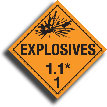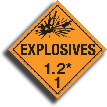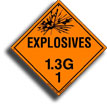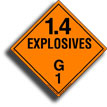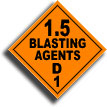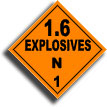|
"A": Primary explosive substance.
"B": Article containing a primary explosive substance and not containing two or more effective protective features. Some articles, such as detonators for blasting, detonator assemblies for blasting and primers, cap-type, are included, even though they contain primary explosives.
"C": Propellant explosive substance or other deflagrating explosive substance or article containing such explosive substance.
"D": Secondary detonating explosive substance or black powder or article containing a secondary detonating explosive substance, in each case without means of initiation and without a propelling charge, or article containing a primary explosive substance and containing two or more effective protective features.
"E": Article containing a secondary detonating explosive substance without means of initiation, with a propelling charge (other than one containing flammable liquid, gel or hypergolic liquid).
"F": Article containing a secondary detonating explosive substance with its means of initiation, with a propelling charge (other than one containing flammable liquid, gel or hypergolic liquid) or without a propelling charge.
"G": Pyrotechnic substance or article containing a pyrotechnic substance, or article containing both an explosive substance and an illuminating, incendiary, tear-producing or smoke-producing substance (other than a water-activated article or one containing white phosphorus, phosphide or flammable liquid or gel or hypergolic liquid).
"H": Article containing both an explosive substance and white phosphorus.
"J": Article containing both an explosive substance and flammable liquid or gel.
"K": Article containing both an explosive substance and a toxic chemical agent.
"L": Explosive substance or article containing an explosive substance and presenting a special risk (e.g., due to water-activation or presence of hypergolic liquids, phosphides or pyrophoric substances) needing isolation of each type.
"N": Articles containing only extremely insensitive detonating substances.
"S": Substance or article so packed or designed that any hazardous effects arising from accidental functioning are limited to the extent that they do not significantly hinder or prohibit fire fighting or other emergency response efforts in the immediate vicinity of the package.
|
